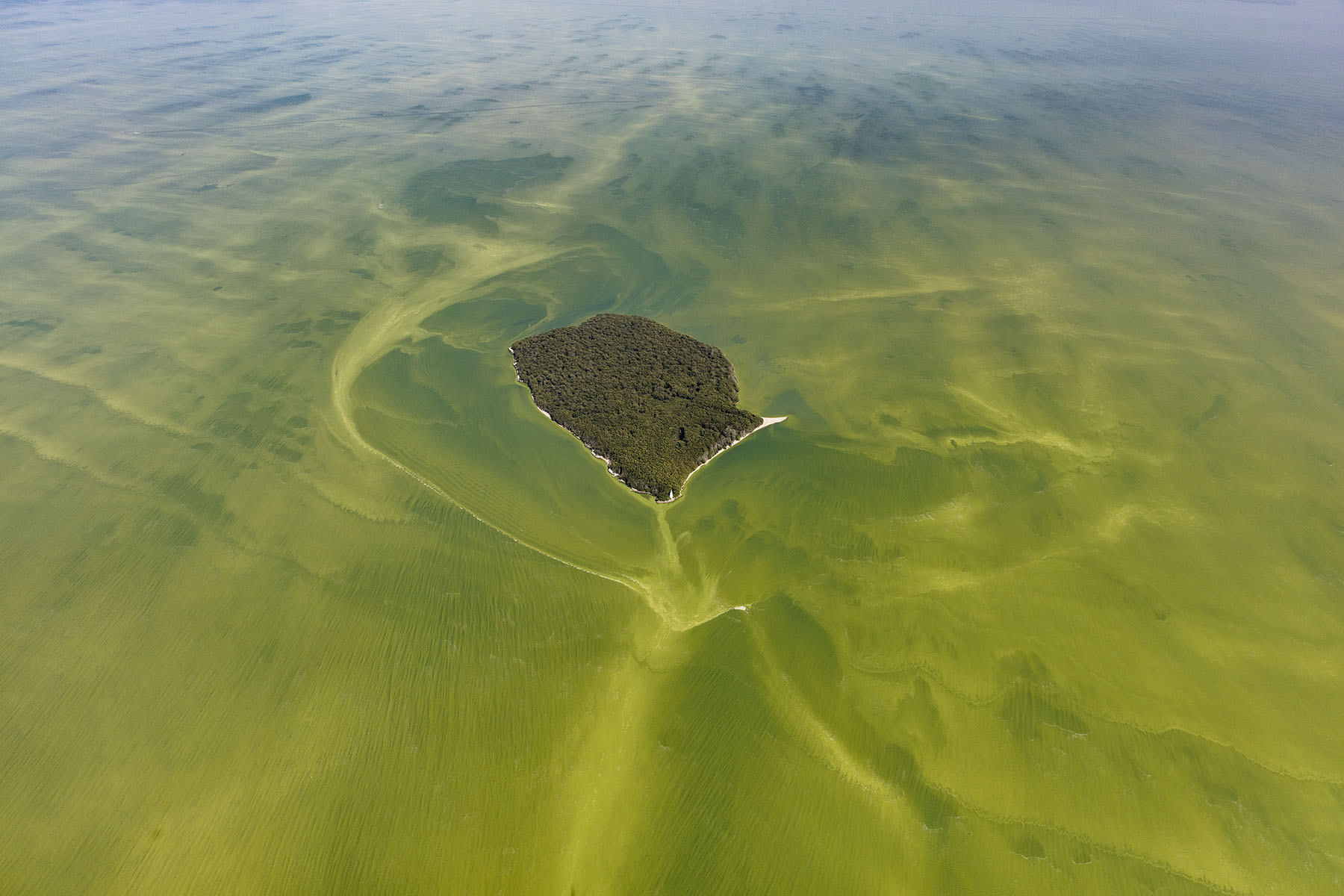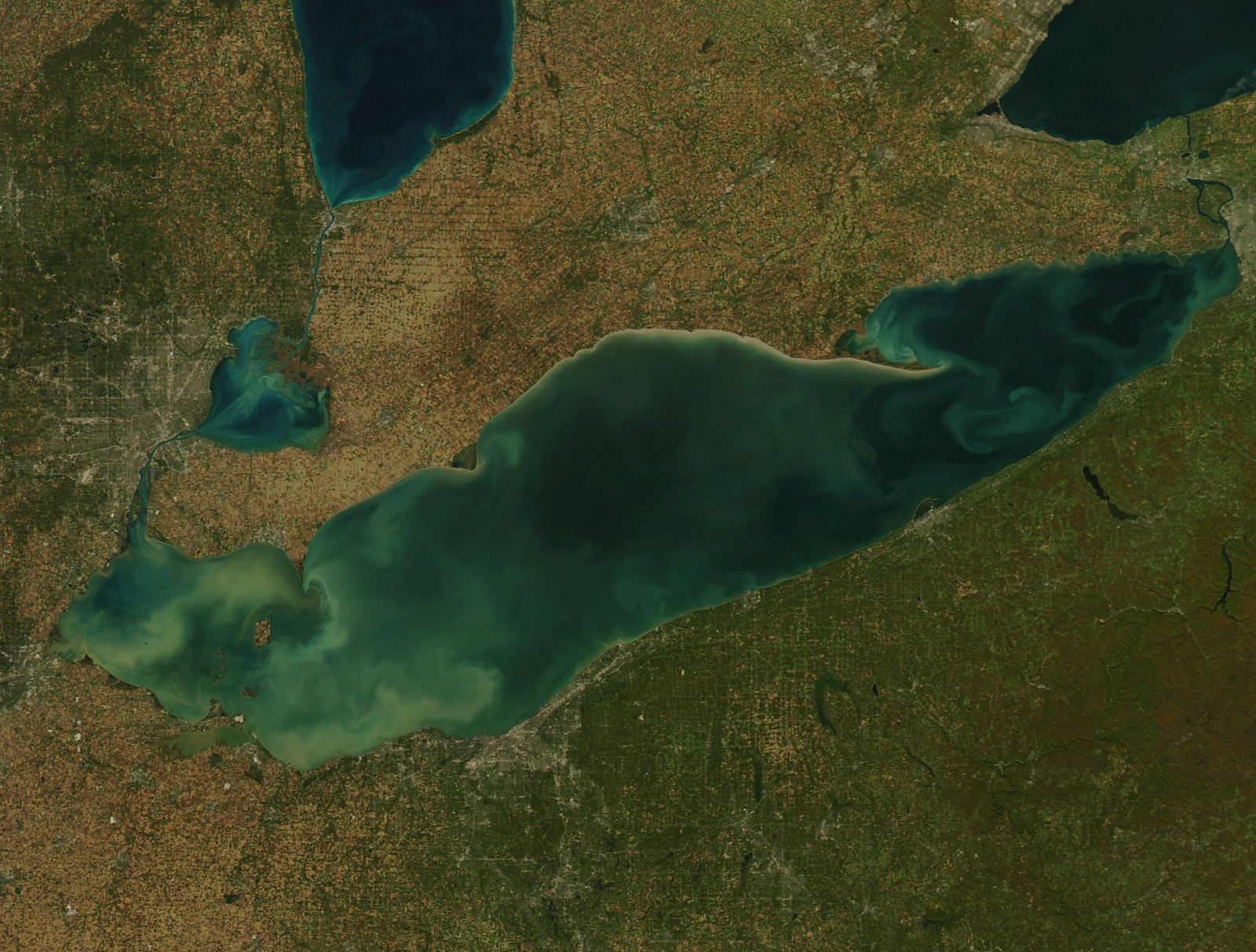Article by Andrew Jones
On 2 August 2014, the 500,000 residents of Toledo, Ohio woke up to a city alert. "Urgent Water Notice! DO NOT DRINK THE WATER. DO NOT BOIL THE WATER." Hours later, local shops had sold out of bottled water. Toledoans scattered as far as 100 km (62 miles) from the city in search of water.
Algal blooms in Lake Erie, the 10th largest freshwater lake in the world, had infused Toledo's tap water with microcystin, a potent toxin that can cause vomiting, diarrhea, and liver failure.
In the past few decades, excessive phosphorus and nitrogen have spilled into the lake and fueled runaway toxic algal growth. Signs warning "DANGER. Avoid all contact with water" have become summer mainstays for western Lake Erie beaches.

Water sample from Lake Erie taken Sept 2017 (Photo Credit: NOAA GLERL)
Describing the algae, local boater Dave Spangler commented, "It gets so thick that it slows the boats," and compared the smell to "Grandma's basement, that musty smell."
The blooms affect more than just drinking water. Mats of algae block sunlight from reaching underwater plants. When the algae die, the excessive biomatter sets off a frenzy of microbe activity that rapidly consumes the dissolved oxygen in the lake, suffocating all fish and aquatic life in the process. The resulting dead zone can span over a third of the lake.
Agricultural runoff plays the main culprit. Modern fertilizer practices and vast piles of animal waste from concentrated animal feeding operations provide the excess phosphorus and nitrogen, while heavy rainstorms push those nutrients into the lake.
Historically, people have found some success rallying against point-source pollution. If a city's sewage plant is spilling pollutants into the lake, that is relatively easy to target and remedy. But when the sources are thousands of independent agribusinesses spread across an entire watershed, pollution becomes practically—and politically—more difficult to regulate.
For years, the people of Toledo pushed traditional legal channels to enforce existing regulations and write new ones to protect their drinking water, but to no avail. Frustrated by the inaction, they explored other avenues.
Should Trees Have Standing?
In the past, groups have filed lawsuits to defend ecosystems from destruction, but more often than not, courts have ruled that the groups did not have sufficient legal standing to bring the suit. To have legal standing, you must suffer direct injury or harm.
In response, some have moved to assign legal standing directly to nature. In 1972, law professor Christopher Stone penned the essay Should Trees Have Standing?—Toward Legal Rights for Natural Objects.
It may feel beyond our collective imagination to give nature rights. But, as Stone writes,
"throughout legal history, each successive extension of rights to some new entity has been… a bit unthinkable… Until the rightless thing receives its rights, we cannot see it as anything but a thing for the use of ‘us'—those who are holding rights at the time."
Giving rights to nature would have immediate implications. For a market system to function, businesses must be held accountable for the costs they impose on people downstream. But the effects of pollution on humans are often too diffuse to give the law a proper toehold. Stone specifically referenced the pollution of Lake Erie in the 1970s as an example. In considering the downstream costs, Stone argued we should stretch beyond narrowly defined "homocentric interests" to include the death and suffering of non-human life.
It could be more simple than it sounds. The legal system creates economic value through what it protects. Private property and copyrights have value only because of the law's recognition. In the same way, a lake is given value when the law enforces penalties against those who violate the lake's rights.
Rights of Nature Written Into Law
In recent years, more people have been turning to Stone's argument in an effort to achieve meaningful change. Since 2006, the Rights of Nature have been made into law in cities and countries across the world.
Ecuador became the first nation to recognize the Rights of Nature in its constitution in 2008. The constitutional article begins,
"Nature, or Pacha Mama, where life is reproduced and occurs, has the right to integral respect for its existence and for the maintenance and regeneration of its life cycle, structure, functions, and evolutionary processes. All persons, communities, peoples and nations can call upon public authorities to enforce the rights of nature."
In other words, anybody can go to court to protect life, regardless of the plaintiff's legal standing. Going further than protection against further harm, the article states "Nature has the right to be restored."
Bolivia followed in 2010 with the "Law of the Rights of Mother Earth." The law defines Mother Earth as "the dynamic living system formed by the indivisible community of all life systems and living beings who are interrelated, interdependent, and complementary, which share a common destiny."
In 2017, New Zealand granted legal personhood to the Whanganui River, making it the first river in the world to be recognized as an indivisible and living being. A court in India carried the example forward by declaring the Ganges River and its Yamuna tributary "legal and living entities."

Whanganui River (Photo Credit: Duane Wilkins)
The recognition has persisted beyond symbolism into the courtroom. In 2011, haphazard road construction along the Vilcabamba River in Ecuador threatened downstream ecosystems. Excavated material and debris were discarded into the river. The scarring of hillsides increased erosion, and the ensuing blockages altered her path and increased her flow. Large floods barreled through, destroying ecosystems, risking landslides, and affecting access to clean water.
Rather than argue for personal damages, people downstream filed a constitutional lawsuit on behalf of the river. And the provincial court ruled in favor of the Vilcabamba River.
Still, "happily ever after" has eluded Rights of Nature advocates. People defending the river have struggled to get the Ecuadorian government to enforce the ruling. Meanwhile, oil drilling operations continue to expand into the Ecuadorian rainforest. The Bolivian government incentivizes the slash-and-burn agriculture that Bolivians blame for sparking unprecedented fires in the Chiquitano dry forest. The Supreme Court of India overturned the earlier ruling, stating that giving legal rights to rivers was "legally unsustainable."
Conversely, the Whanganui River's personhood has so far garnered more respect. The bill is the culmination of a century of struggle by the indigenous peoples, the Maori, and recognizes the intertwined fates of the people and of the river. Among other innovations, its comprehensive framework provides for a human council to directly oversee the river's interests.
In turn, the global movement inspired the Toledoans for Safe Water, a grassroots group on the shore of Lake Erie, to write the Lake Erie Bill of Rights (LEBOR).
Toledo Votes for the Lake Erie Bill of Rights

Harmful Algal Bloom in Lake Erie: September 20, 2017 (Photo Credit: Aerial Associates Photography, Inc. by Zachary Haslick)
The bill states,
"it has become necessary that we... extend legal rights to our natural environment in order to ensure that the natural world, along with our values, our interests, and our rights, are no longer subordinated to the accumulation of surplus wealth and unaccountable political power."
After years of rallying public support around LEBOR, the city of Toledo granted legal rights to Lake Erie in 2019. Whereas many other Rights of Nature advances were instituted by courts or legislatures, the people of Toledo passed LEBOR with 61% of the vote.
Less than 11 hours after LEBOR passed, Drewes Farms Partnership and the State of Ohio brought a suit against the City of Toledo, challenging LEBOR as unconstitutional and unlawful.
Drewes Farms' lawsuit is remarkable in that it goes to such lengths to explain how LEBOR prevents them from running their business as it currently operates. This is precisely LEBOR's motivation. Because Drewes Farms is correct. No real mitigation to excess runoff can be made without fundamentally changing our approach to agriculture with its vast monocropping, excessive artificial fertilizers, million-dollar, 65-ton tractors with 1,000-gallon diesel tanks, and cramped complexes of suffering animals.
This is not to belittle the plight of Drewes Farms. From its perspective, it has responded to market constraints for decades to eke out a profit in a commoditized business. To survive, it probably loaded itself with debt in order to subdue more land with bigger machines. It had been judged only by its ability to turn a profit. But now, an upstate town was trying to burden it with new demands? To comply with the full intention of LEBOR would require extraordinary help. Million-dollar machines with million-dollar debts might be rendered unusable. LEBOR does nothing to help it.
The two sides presented oral arguments in January 2020. Drewes Farms and the State of Ohio have been forced to juggle contradictory arguments. They argue Toledo has no right to reach beyond its jurisdiction to protect its drinking water, but claim that the state and businesses have the right to pollute beyond their borders.
Whose Rights Prevail?
At the heart of the case is "Whose rights prevail?" The rights of the people of Toledo to clean water? The rights of the Lake Erie ecosystem to "exist, flourish, and naturally evolve"? Or the rights of Drewes Farms and their colleagues to operate as they always have?
The broader the umbrella of rights, the more frequently those rights will come into conflict. And then, which right should be given priority?
The Rights of Nature movement is an attempt to recenter our priorities. It claims that protecting access to the essentials of life—clean air and clean water—is a higher priority than a corporation's access to private property and profit, that a living ecosystem's right to exist is a higher priority than humanity's right to exploit life without recourse.
The movement is opposed by powerful, entrenched interests. But its power lies in its simplicity. To overturn LEBOR, a judge must rule that, in fact, no, the people of Toledo and the lake's ecosystem do not possess the right to a clean and healthy environment and that it is lawful for corporations and governments to deprive Lake Erie of such.
Toward the end of "Should Trees Have Standing?" Christopher Stone moves beyond the practical to the philosophical. He asks,
"What is it within us that gives us this need not just to satisfy basic biological wants, but to extend our wills over things, to objectify them, to make them ours, to manipulate them, to keep them at a psychic distance?"
Our view of nature as objects to be dominated has led to the destruction of land and life. And this mindset is echoed in our law's treatment of other life. Stone saw the reinforcement of our "separateness" from nature as inhibiting our personal growth as moral beings.
Stone recalls the Supreme Court's role in undoing the racial segregation of schools in the U.S., reminding us that the ruling's cultural importance swelled beyond its practical consequences. The ruling "awakened us to moral needs which, when made visible, could not be denied."
In the same way, giving legal rights to nature can be a crucial step toward recentering our relationship with life.

Harmful Algal Bloom in Lake Erie taken Oct 2015 (Photo Credit: NOAA Great Lakes CoastWatch)